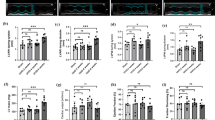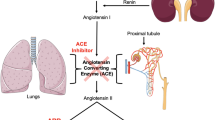Abstract
Hypertension and related oxidative stress are involved in the pathogenesis of any renal diseases. Angiotensin-converting enzyme inhibitors have multi-directional renoprotective effects. In this study, we aimed to investigate whether lisinopril treatment has any biochemical alterations on renal tissue in l-NAME (Nε-nitro-l-arginine methyl ester) induced hypertension model. Twenty-eight Sprague–Dawley rats were included in this study and divided into four equal groups (n = 7): control group, l-NAME treated group (75 mg/kg/day), l-NAME plus lisinopril treated group and only lisinopril treated group (10 mg/kg/day). l-NAME and lisinopril were continued for 6 weeks. Systolic blood pressures were measured by using tail cuff method. In biochemical analysis, malondialdehyde (MDA, an index of lipid peroxidation) levels, the activities of superoxide dismutase (SOD), catalase (CAT), and glutathione peroxidase (GSH-Px) in renal tissues were used as markers of oxidative stress-induced renal impairment. Microalbumin and N-acetyl-β-d-glucosaminidase (NAG) in urine were determined as markers of renal tubular damage related to hypertension. Chronic l-NAME administration resulted in a significant depletion of serum nitric oxide (NO). When compared with control group, serum creatinine, microalbumin, urine NAG, renal tissue MDA level, and CAT activities were significantly high, while renal tissue SOD and GSH-Px activities low in l-NAME group. In the l-NAME plus lisinopril treated group, serum creatinine, microalbumin and urine NAG, renal MDA level and CAT activity decreased, whereas SOD, GSH-Px activities in renal tissue and serum NO levels were increased. Thus, lisinopril treatment reversed these effects. There were not any significant difference between l-NAME plus lisinopril treated group and control group concerning serum creatinine, renal tissue MDA level and SOD, GSH-Px, CAT activities. These results suggest that lisinopril could diminish biochemical alterations in l-NAME induced hypertensive renal damage that occurs by oxidative stress.




Similar content being viewed by others
References
Kopkan L, Majid DS (2006) Enhanced superoxide activity modulates renal function in no-deficient hypertensive rats. Hypertension 47:568–572
Khattab MM, Mostafa A, Al-Shabanah O (2005) Effects of captopril on cardiac and renal damage, and metabolic alterations in the nitric oxide-deficient hypertensive rat. Kidney Blood Press Res 28:243–250
Ozguner F, Öktem F, Ayata A, Koyu A, Yilmaz R (2005) A novel antioxidant agent caffeic acid phenethyl ester (CAPE) prevents long-term mobile phone exposure-induced renal impairment in rat: prognostic value of malondialdehyde, N-acetyl-β-d-glucosaminidase and nitric oxide determination. Mol Cell Biochem 277:73–80
Öktem F, Ozguner F, Yilmaz HR, Uz E, Dündar B (2006) Melatonin reduces urinary excretions of N-acetyl-β-d-glucosaminidase, albumin and renal oxidative markers in diabetic rats. Clin Exp Pharmacol Physiol 33:95–101
Usui M, Egashira K, Kitamoto S, Koyanagi M, Katoh M, Kataoka C, Shimokawa H, Takeshita A (1999) Pathogenic role of oxidative stress in vascular angiotensin-converting enzyme activation in long-term blockade of nitric oxide synthesis in rats. Hypertension 34:546–551
Schnackenberg CG, Welch WJ, Wilcox CS (1998) Normalisation of blood pressure and renal vascular resistance in SHR with a membrane-permeable superoxide dismutase mimetic: role of nitric oxide. Hypertension 32:59–64
Zhan CD, Sindhu RK, Pang J, Ehdaie A, Vaziri ND (2004) Superoxide dismutase, catalase and glutathione peroxidase in the spontaneously hypertensive rat kidney: effect of antioxidant-rich diet. J Hypertens 22:2025–2033
Dincer Y, Telci A, Kayalı R, Yilmaz IA, Çakatay U, Akçay T (2002) Effect of α-lipoic acid on lipid peroxidation and anti-oxidant enzyme activities in diabetic rats. Clin Exp Pharmacol Physiol 29:281–284
Bosomworth MP, Aparicio SR, Hay AWM (1999) Urine N-acetyl-beta-d-glucosaminidase—a marker of tubular damage ? Nephrol Dial Transplant 14:620–626
Pere AK, Lindgren L, Tuomainen P, Krogerus L, Rauhala P, Laakso J, Karppanen H, Vapaatalo H, Ahonen J, Mervaala EM (2000) Dietary potassium and magnesium supplementation in cyclosporine-induced hypertension and nephrotoxicity. Kidney Int 58:2462–2472
Tungsanga K, Sriboonlue P, Futrakul P, Yachantha C, Tosukhowong P (2005) Renal tubular cell damage and oxidative stress in renal stone patients and the effect of potassium citrate treatment. Urol Res 33:65–69
Dobrian AD, Schriver SD, Prewitt RL (2001) Role of angiotensin II and free radicals in blood pressure regulation in a rat model of renal hypertension. Hypertension 38:361–366
Francischetti A, Ono H, Frohlich ED (1998) Renoprotective effects of felodipine and/or enalapril in spontaneously hypertensive rats with and without l-NAME. Hypertension 31:795–801
Gokcimen A, Kocak A, Kilbas S, Bayram D, Kilbas A, Cim A, Kockar C, Kutluhan S (2007) Effect of lisinopril on rat liver tissues in l-NAME induced hypertension model. Mol Cell Biochem 296:159–164
Lowry OH, Rosebrough NJ, Farr AL, Randall RJ (1951) Protein measurement with the folin phenol reagent. J Clin Chem 193:265–269
Draper HH, Hadley M (1990) Malondialdehyde determination as index of lipid peroxidation. Methods Enzymol 186:421–431
Yakata M, Sugita O, Sakai T, Uchiyama K, Wada K (1983) Urinary enzyme determination and its clinical significance. Enzyme derived from the kidney epithelium-N acetyl beta-d-glucosaminidase. 4. Preclinical evaluation of the urinary NAG activity and changes in the renal disease. Rinsho Byori 56:90–101
Durak I, Yurtarslani Z, Canbolat O, Akyol O (1993) A methodological approach to superoxide dismutase (SOD) activity assay based on inhibition of nitroblue tetrazolium (NBT) reduction. Clin Chim Acta 214:103–104
Paglia DE, Valentine WN (1967) Studies on the quantitative and qualitative characterization of erythrocyte glutathione peroxidase. J Lab Clin Med 70:158–169
Aebi Y (1984) Catalase in vitro. Methods Enzymol 105:121–126
Ruiz-Ortega M, Ortiz A (2005) Angiotensin II and reactive oxygen species. Antioxid Redox Signal 7:1258–1260
Goldstein S, Czapski G, Lind J, Merenyi G (2000) Tyrosine nitration by simultaneous generation of (·)NO and O-(2) under physiological conditions: how the radicals do the job. J Biol Chem 275:3031–3036
Khattab MM, Nagi MN (2007) Thymoquinone supplementation attenuates hypertension and renal damage in nitric oxide deficient hypertensive rats. Phytother Res 21:410–414
Sainz J, Wangensteen R, Gómez IR, Moreno JM, Chamorro V, Osuna A, Bueno P, Vargas F (2005) Antioxidant enzymes and effects of tempol on the development of hypertension induced by nitric oxide inhibition. Am J Hypertens 18:871–877
Nabha L, Garbern JC, Buller CL, Charpie JR (2005) Vascular oxidative stress precedes high blood pressure in spontaneously hypertensive rats. Clin Exp Hypertens 27:71–82
Zhang Y, Jang R, Mori TA, Croft KD, Schyvens CG, McKenzie KU, Whitworth JA (2003) The anti-oxidant tempol reverses and partially prevents adrenocorticotrophic hormone-induced hypertension in the rat. J Hypertens 21:1513–1518
Husain K (2002) Exercise conditioning attenuates the hypertensive effects of nitric oxide synthase inhibitor in rat. Mol Cell Biochem 231:129–137
Porteri E, Rodella L, Rizzoni D, Rezzani R, Paiardi S, Sleiman I, De Ciuceis C, Boari GE, Castellano M, Bianchi R, Agabiti-Rosei E (2005) Effects of olmesartan and enalapril at low or high doses on cardiac, renal and vascular interstitial matrix in spontaneously hypertensive rats. Blood Press 14:184–192
Pereira LM, Bezerra DG, Machado DL, Mandarim-de-Lacerda CA (2004) Enalapril attenuates cardiorenal damage in nitric-oxide-deficient spontaneously hypertensive rats. Clin Sci 106:337–343
Verdecchia P, Angeli F, Mazzotta G, Ambrosio G, Reboldi G (2010) Angiotensin receptor blockers in hypertension. New insights from Japan. Hypertens Res 33:394–397
Pérez-Guerrero C, Alvarez de Sotomayor M, Jimenez L, Herrera MD, Marhuenda E (2003) Effects of simvastatin on endothelial function after chronic inhibition of nitric oxide synthase by l-NAME. Cardiovasc Pharmacol 42:204–210
Husain K, Hazelrigg SR (2002) Oxidative injury due to chronic nitric oxide synthase inhibition in rat: effect of regular exercise on the heart. Biochim Biophys Acta 1587:75–82
Makino A, Skelton MM, Zou AP, Cowley AW Jr (2003) Increased renal medullary H2O2 leads to hypertension. Hypertension 42:25–30
Zhang C, Imam SZ, Ali SF, Mayeux PR (2002) Peroxynitrite and the regulation of Na(+), K(+)-ATPase activity by angiotensin II in the rat proximal tubule. Nitric Oxide 7:30–35
Author information
Authors and Affiliations
Corresponding author
Rights and permissions
About this article
Cite this article
Öktem, F., Kirbas, A., Armagan, A. et al. Lisinopril attenuates renal oxidative injury in l-NAME-induced hypertensive rats. Mol Cell Biochem 352, 247–253 (2011). https://doi.org/10.1007/s11010-011-0760-2
Received:
Accepted:
Published:
Issue Date:
DOI: https://doi.org/10.1007/s11010-011-0760-2




